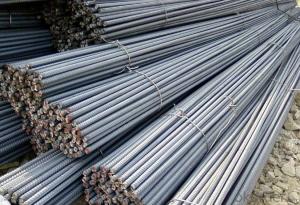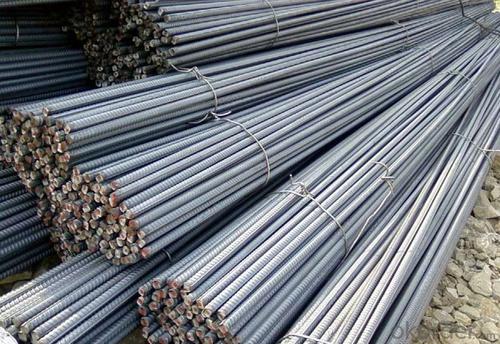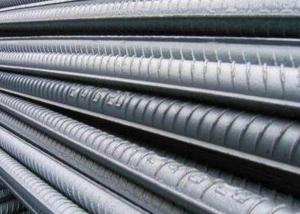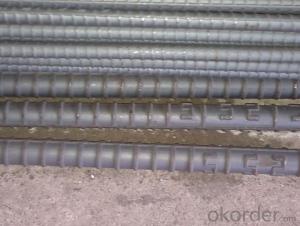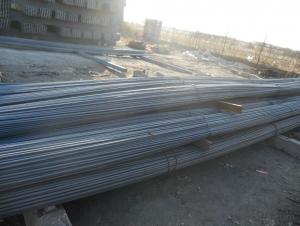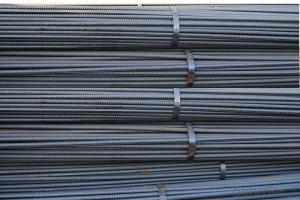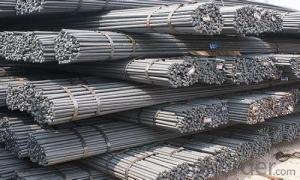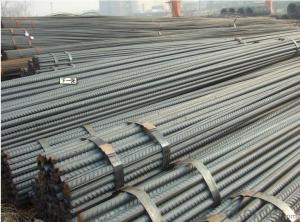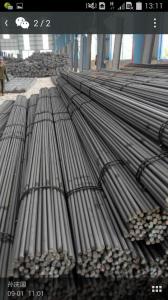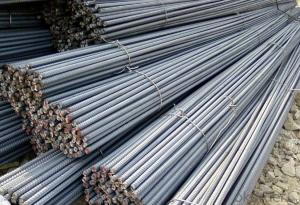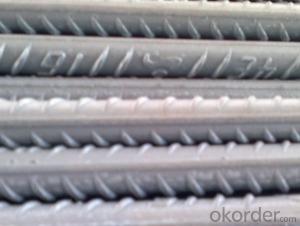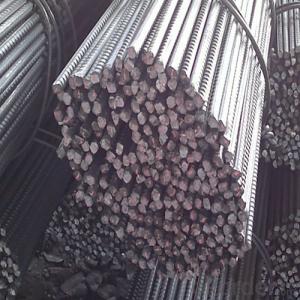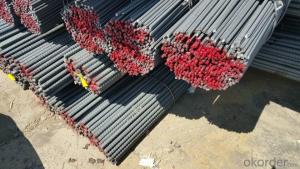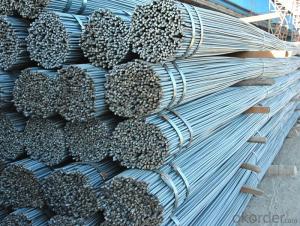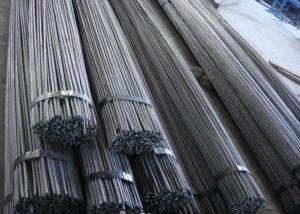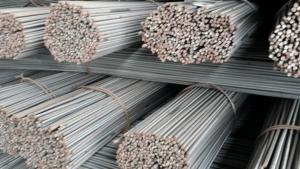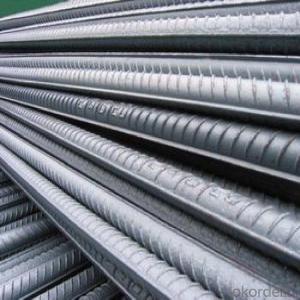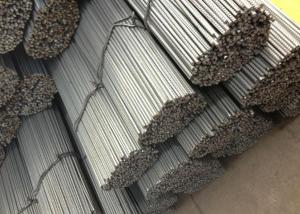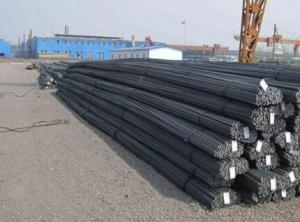Hot rolled deformed bar BS4449 G460B HRB400
- Loading Port:
- Tianjin
- Payment Terms:
- TT OR LC
- Min Order Qty:
- 25 m.t.
- Supply Capability:
- 20000000 m.t./month
OKorder Service Pledge
OKorder Financial Service
You Might Also Like
Deformed Bar Details:
| Minimum Order Quantity: | m.t. | Unit: | m.t. | Loading Port: | |
| Supply Ability: | m.t./month | Payment Terms: | TT OR LC | Package: | wire rod packing |
Product Description:
Product Description:
Specifications of HRB400 Deformed Steel Bar:
Standard | GB | HRB400 | |
Diameter | 6mm,8mm,10mm,12mm,14mm,16mm,18mm,20mm, 22mm,25mm,28mm,32mm,36mm,40mm,50mm | ||
Length | 6M, 9M,12M or as required | ||
Place of origin | Hebei, China mainland | ||
Advantages | exact size, regular package, chemical and mechanical properties are stable. | ||
Type | Hot rolled deformed steel bar | ||
Brand name | DRAGON | ||
Chemical Composition: (Please kindly find our chemistry of our material based on HRB500 as below for your information)
Grade | Technical data of the original chemical composition (%) | ||||||
C | Mn | Si | S | P | V | ||
HRB400 | ≤0.25 | ≤1.60 | ≤0.80 | ≤0.045 | ≤0.045 | 0.04-0.12 | |
Physical capability | |||||||
Yield Strength (N/cm²) | Tensile Strength (N/cm²) | Elongation (%) | |||||
≥400 | ≥570 | ≥14 | |||||
Theoretical weight and section area of each diameter as below for your information:
Diameter(mm) | Section area (mm²) | Mass(kg/m) | Weight of 12m bar(kg) |
6 | 28.27 | 0.222 | 2.664 |
8 | 50.27 | 0.395 | 4.74 |
10 | 78.54 | 0.617 | 7.404 |
12 | 113.1 | 0.888 | 10.656 |
14 | 153.9 | 1.21 | 14.52 |
16 | 201.1 | 1.58 | 18.96 |
18 | 254.5 | 2.00 | 24 |
20 | 314.2 | 2.47 | 29.64 |
22 | 380.1 | 2.98 | 35.76 |
25 | 490.9 | 3.85 | 46.2 |
28 | 615.8 | 4.83 | 57.96 |
32 | 804.2 | 6.31 | 75.72 |
36 | 1018 | 7.99 | 98.88 |
40 | 1257 | 9.87 | 118.44 |
50 | 1964 | 15.42 | 185.04 |
Usage and Applications of HRB400 Deformed Steel Bar:
Deformed bar is widely used in buildings, bridges, roads and other engineering construction. Big to highways, railways, bridges, culverts, tunnels, public facilities such as flood control, dam, small to housing construction, beam, column, wall and the foundation of the plate, deformed bar is an integral structure material. With the development of world economy and the vigorous development of infrastructure construction, real estate, the demand for deformed bar will be larger and larger..
Packaging & Delivery of HRB400 Deformed Steel Bar:
Packaging Detail: products are packed in bundle and then shipped by container or bulk vessel, deformed bar is usually naked strapping delivery, when storing, please pay attention to moisture proof. The performance of rust will produce adverse effect.
Each bundle weight: 2-3MT, or as required
Payment term: TT or L/C
Delivery Detail: within 45 days after received advanced payment or LC.
Label: to be specified by customer, generally, each bundle has 1-2 labels
Trade terms: FOB, CFR, CIF
- Q: What is the purpose of ribbed steel rebars?
- The purpose of ribbed steel rebars is to provide reinforcement and enhance the strength of concrete structures, such as buildings, bridges, and roads. The ribs on the rebar increase the bond between the steel and concrete, preventing slippage and improving the overall structural integrity.
- Q: What are the guidelines for the proper anchoring of steel rebars in slabs?
- To ensure the structural integrity and strength of a concrete slab, it is crucial to properly anchor steel rebars. Here are some guidelines to consider: 1. Embedment depth: The concrete slab should have a specific depth of embedding for the rebars. This depth is determined based on factors like rebar size, strength, and load requirements. It is essential to adhere to the recommended embedment depth to ensure effective force transfer between the rebar and concrete. 2. Spacing: Within the slab, rebars should be evenly spaced at regular intervals to provide uniform reinforcement. The spacing is determined by design requirements and expected load. Following the suggested spacing guidelines will distribute the load evenly, preventing slab cracking or failure. 3. Lap length: When joining multiple rebars together, a lap splice is employed. The lap length refers to the minimum overlap required for proper force transfer between rebars. It is crucial to adhere to the specified lap length to maintain reinforcement integrity. 4. Edge distance: To prevent edge failure, rebars should be placed at a specific distance from the slab's edges. Edge distance is determined by factors such as bar size, concrete cover, and design requirements. Adhering to the recommended edge distance ensures proper anchoring, preventing concrete spalling or cracking near the edges. 5. Concrete cover: Rebars require a minimum concrete cover for corrosion protection and fire resistance. The concrete cover is the distance between the rebar's outer surface and the nearest concrete surface. Following the suggested concrete cover guidelines maintains the durability and longevity of steel rebars. 6. Accurate placement and alignment: Proper reinforcement is achieved by accurately placing and aligning rebars within the slab. They should be positioned at the correct depth, spacing, and alignment as per design specifications. This ensures secure anchoring and contributes to the overall strength of the slab. It is important to note that these guidelines may vary based on project requirements, local building codes, and design standards. Therefore, it is recommended to consult a qualified structural engineer or follow guidelines provided by relevant authorities to ensure proper anchoring of steel rebars in slabs.
- Q: Can steel rebars be used in tunnels and underground structures?
- Yes, steel rebars can be used in tunnels and underground structures. They are commonly used to reinforce and strengthen the concrete used in these structures, providing additional stability and load-bearing capacity.
- Q: Can steel rebars be used in residential foundation construction?
- Yes, steel rebars can be used in residential foundation construction. Steel rebars provide reinforcement and strength to concrete, making them an essential component in the construction of residential foundations.
- Q: How do steel rebars affect the overall sustainability of a structure?
- Steel rebars have a significant impact on the overall sustainability of a structure. Firstly, the use of steel rebars contributes to the strength and durability of the building, ensuring its longevity and reducing the need for frequent repairs or replacements. This leads to a reduction in the consumption of raw materials and energy required for construction, making the structure more sustainable. Additionally, steel rebars help improve the structural integrity of a building, making it more resistant to natural disasters such as earthquakes and hurricanes. By enhancing the safety and resilience of the structure, steel rebars minimize the potential for damage and loss, which in turn reduces the environmental impact associated with reconstruction and waste generation. Furthermore, steel rebars can be recycled at the end of a building's life cycle. Steel is highly recyclable, and reusing steel rebars significantly reduces the demand for virgin steel production and the associated carbon emissions. Recycling steel also conserves natural resources and reduces landfill waste, making it a more sustainable option than using other materials. Moreover, the use of steel rebars in structures allows for greater design flexibility and adaptability. This means that buildings can be easily modified or repurposed, reducing the need for demolition and reconstruction. The ability to repurpose existing structures reduces waste and energy consumption, contributing to the overall sustainability of the built environment. In summary, steel rebars positively impact the overall sustainability of a structure through their durability, strength, and recyclability. By enhancing the longevity, safety, and adaptability of a building, steel rebars reduce the environmental impact associated with construction, maintenance, and demolition.
- Q: What are the common defects or issues associated with steel rebars?
- Some common defects or issues associated with steel rebars include corrosion, improper bending or straightening, inadequate cover or concrete protection, insufficient anchorage or lap length, and incorrect spacing or alignment.
- Q: Can steel rebars be used in structures with high fire safety requirements?
- Yes, steel rebars can be used in structures with high fire safety requirements. Steel has a high melting point and good fire resistance properties, making it suitable for use in fire-resistant structures. Additionally, steel rebars can be encased in fire-resistant materials such as concrete or intumescent coatings to enhance their fire resistance capabilities.
- Q: Can steel rebars be used in tunnels and underground structures?
- Tunnels and underground structures can indeed utilize steel rebars. These rebars are frequently employed in construction projects for the purpose of reinforcing concrete structures and providing added strength and durability. When it comes to tunnels and underground structures, where stability and load-bearing capacity are of utmost importance, incorporating steel rebars into the concrete walls, floors, and ceilings is a common practice to enhance their structural integrity. The utilization of rebars helps in distributing the load and resisting potential cracks or deformations that may arise from the pressure exerted by the surrounding soil or water. Furthermore, steel rebars possess resistance against corrosion, making them suitable for underground environments that may contain moisture and other corrosive elements. All in all, steel rebars play a vital role in the construction of tunnels and underground structures by ensuring their safety and longevity.
- Q: What are the different types of steel rebars used in dam constructions?
- There are generally three types of steel rebars commonly used in dam constructions: mild steel rebar, high-strength deformed rebar, and epoxy-coated rebar. These rebars serve different purposes based on their properties and are chosen accordingly for specific areas of the dam structure. Mild steel rebars are typically used in non-structural areas, while high-strength deformed rebars provide greater tensile strength for critical structural elements. Epoxy-coated rebars are used in environments where corrosion resistance is crucial, such as areas exposed to water or chemicals.
- Q: How do steel rebars contribute to the overall resistance against natural disasters?
- Steel rebars contribute to the overall resistance against natural disasters in various ways. Firstly, steel rebars are extensively used in reinforced concrete structures such as buildings, bridges, and dams, which are designed to withstand natural disasters like earthquakes and hurricanes. The addition of steel rebars increases the structural integrity of these concrete elements, making them more resistant to the forces exerted by such disasters. During earthquakes, the flexible nature of steel rebars allows them to absorb and distribute the seismic energy throughout the structure. This helps in dissipating the destructive forces and reducing the chances of collapse or severe damage. The presence of steel rebars also enhances the ductility of reinforced concrete structures, which means they can deform and flex without breaking, thus improving their overall resilience against seismic events. In the case of hurricanes or strong winds, steel rebars provide additional strength and stability to concrete structures. They act as reinforcement, preventing the concrete from cracking or crumbling under the pressure of high winds. The combination of the tensile strength of steel and the compressive strength of concrete creates a robust and durable structure that can withstand the powerful forces generated by hurricanes. Furthermore, steel rebars play a crucial role in the construction of flood-resistant structures. During flooding events, the strength and corrosion resistance of steel rebars ensure the structural integrity of buildings and other infrastructure, preventing them from being severely damaged or washed away. The use of steel rebars in flood-prone areas helps in creating resilient structures that can withstand the erosive forces of water and remain intact. Overall, steel rebars significantly contribute to the overall resistance against natural disasters by enhancing the strength, durability, and flexibility of concrete structures. Their presence improves the structural integrity and resilience of buildings, bridges, and other infrastructure, making them more capable of withstanding the destructive forces unleashed by earthquakes, hurricanes, and floods.
Send your message to us
Hot rolled deformed bar BS4449 G460B HRB400
- Loading Port:
- Tianjin
- Payment Terms:
- TT OR LC
- Min Order Qty:
- 25 m.t.
- Supply Capability:
- 20000000 m.t./month
OKorder Service Pledge
OKorder Financial Service
Similar products
Hot products
Hot Searches
Related keywords
